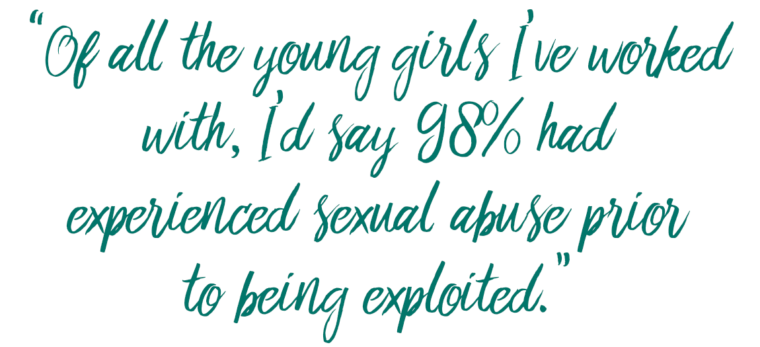Child sex trafficking is a subject that requires creative solutions.
Research tell us that as many as 360,000 children in the United States alone are at risk of being trafficked or sexually exploited each year. 1
As trafficking continues to affect children, both in the US and across the globe, it is vital that communities address the issue head-on. We need to invest in prevention, intervention, and services to help victims heal. For some expert advice on how to combat trafficking, we sat down with Sharon Rikard, Founder of Doors to Freedom, a non-profit that provides a safe haven for survivors of sex trafficking.
Darkness to Light (D2L): Why was Doors to Freedom established?
Sharon Rikard (SR): Doors to Freedom was established in September of 2011 to provide a safe place for survivors of sex trafficking to experience a transformed life. We started by offering survivors assistance with their education through a day-time program. We would pick them up in the community and bring them to our office for as long as they were willing to work on that education. We saw approximately 30 girls in our day-time program. Since opening our 24/7 facility in April, we have housed eight girls. One young lady has already completed our program and is doing well.
D2L: Research estimates that 70-90% of children who are sexually trafficked were sexually abused in a non-commercial manner prior to being trafficked.2 Do you find that to be true?
SR: Of all the young girls I’ve worked with, I’d say 98% had experienced sexual abuse prior to being exploited.
D2L: What services make the greatest impact on the women you help?
SR: Of all the services we provide, including community services, I’d say our educational program has produced the greatest impact in the lives of the girls. The program gives them the confidence they need to be motivated to work harder in their studies. When a child is being abused, one of the areas that suffers is their education. Once we fill in the gaps of their education, they begin to thrive. It’s a beautiful thing to watch as a girl embraces her future through her education.

D2L: What would you like to see Doors to Freedom do to aid victims further in the future?
SR: Currently, the population we are serving are minors, 14-17. We are licensed to provide services to survivors up to the age of 21. However, it is not wise to mix such a wide age difference with this population. So, we’d like to expand our program to separate those 18 and older, offering them the same services we currently offer to minors.
D2L: What would you say is the biggest challenges in aiding CSEC victims?
SR: Most of the young ladies we have worked with did not have the same opportunities as other youth. Because of this they don’t really have interests, hobbies, or necessarily know what they like to do. So, we try to expose them to different sports, dance, art, etc. We have one young lady that has never expressed an interest in art, yet she is extremely artistic. There is another that enjoys ice skating and is a natural, however, she never had the opportunity to skate before.
D2L: What would be your advice to law enforcement, parents, and bystanders when confronted with a CSEC survivor?
SR: To remember the minor is a victim and therefore should be treated as such. An understanding of how youth are psychologically coerced is also necessary so that their approach would be through the lens of trauma. For parents/bystanders, remember that the people these kids are with are very dangerous people. They should never try to intervene without the help of law enforcement. If they were to attempt to intervene on their own, they could put themselves and/or the youth in danger. So many minors do not self-identify as a victim, therefore making it even more difficult. Psychological manipulation can’t be seen. Nor can the fear that often keeps a youth loyal to their trafficker.
D2L: What signs should people look for when identifying someone who is being trafficked?
SR: Control and/or isolation by their pimp, especially in the beginning stages of grooming. If a child has unexplained bruises, extra money, their hair and nails done, hotel keys, or missing several days of school – all of these things should get our attention to begin asking questions.
D2L: If someone does become a victim of sex trafficking, are there suggestions on who they should reach out to for help?
SR: I’d suggest reaching out to your local Child Advocacy Center. There are trained professionals that understand this crime and that can help direct you to your next step. You can also reach out to your local law enforcement agency or the Department of Social Services. The National Human Trafficking Hotline is 1-888-373-7888 or you can text HELP or INFO to 233733.
D2L: What are practical ways for community members to impact change on this issue?
SR: This crime is difficult to identify. However, if you see something that looks unusual, don’t be afraid to reach out to law enforcement. The community can also call their legislators to support legislation that stiffens the penalties for those that buy youth. For example, here in South Carolina, bills have recently been pre-filed in both the South Carolina Senate and House. These bills contain two core provisions: 1) Assignment of prostitution and solicitation to separate criminal codes, and 2) Freezing fines on prostitution and increasing fines on solicitation.
D2L: What resources would you recommend for people to educate themselves on this topic?
SR: The Polaris Project is a great resource as well as Shared Hope International.
D2L: How would prevention on a wide-scale aid in end sex trafficking?
SR: This is an organized crime that thrives on supply and demand like any other business. If you have the supply, you feed the demand. Unfortunately, we are feeding the demand with innocent young girls and boys. Since we know the rate of children who are previous sexually abused before being trafficked is high, we should look to prevention tools such as Stewards of Children® and Commercial Sexual Exploitation of Children trainings to try and prevent child sexual abuse and trafficking from happening. We should also be demanding stiff penalties for those that purchase children.
Darkness to Light’s Commercial Sexual Exploitation of Children training teaches adults about the root cause of commercial sexual exploitation and why preventing sexual abuse is important to reducing the risk of children being sexually exploited. This training is an hour and can be taken online or in-person.
References:
1.The Polaris Project
2. National Institute of Justice. (2007) Commercial sexual exploitation of children: What do we know and what do we do about it? (Publication NCJ 215733). US Department of Justice. Office of Justice Programs.
Sharon Rikard is the Founder and Executive Director of Doors to Freedom, founded in 2011. By 2012, a team of skilled women began working with survivors through Doors to Freedom’s day-time program which provided survivors the opportunity to obtain their GED, receive advocacy services, and transportation. In 2016, Doors to Freedom purchased a home, created an accredited private school, and started offering life skills courses. In April 2018, Doors to Freedom expanded yet again by opening South Carolina’s first residential facility for minor sex trafficking survivors. Doors to Freedom is licensed with DSS to home up to ten girls aged 12 through 21 years old. Throughout this entire process, Sharon’s priority has been seeing each survivor experience new life and restored hope for a beautiful future.
Follow us on social media to stay up to date and join the conversation.



